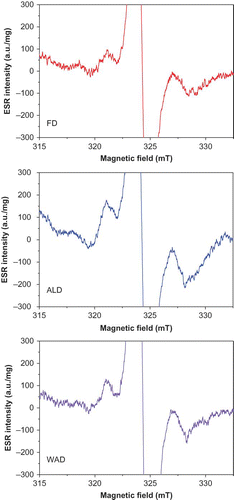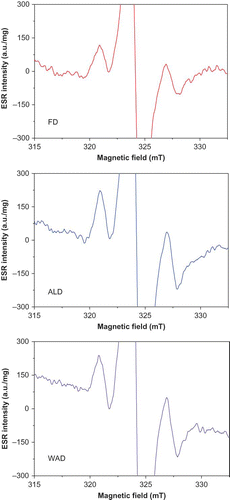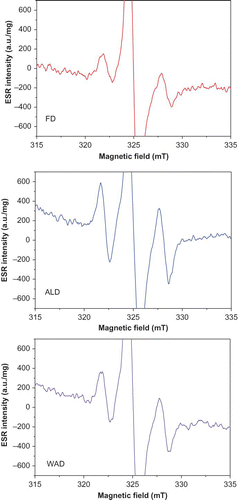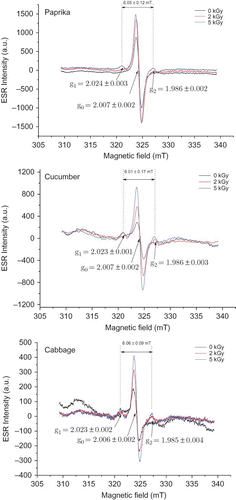Abstract
Fresh vegetables, such as paprika, cucumber, and cabbage, were gamma-irradiated at 0, 2, and 5 kGy. Different pretreatments and selection of samples were compared to obtain improved electron spin resonance spectral features resulting in better detection of irradiation status. The non-irradiated samples exhibited a single central signal at about g0 = 2.007), whose intensity showed a significant increase upon irradiation. However, the irradiation also produced the typical electron spin resonance spectra of the radiation-specific cellulose radicals showing two side peaks (g1 = 2.023 and g2 = 1.986) with a mutual distance of 6 mT. The difference in electron spin resonance responses was observed while analyzing the different parts of the same vegetable. The flesh sample gave better spectral characteristics providing clear radiation-induced electron spin resonance signals. The effect of different drying pretreatments was also evident providing the comparable or improved results when using alcoholic-extraction as an alternative to the conventional freeze-drying technique.
INTRODUCTION
Fresh food commodities normally have a very limited post-harvest life. Enzymatic activity, insect pest infestation, and high initial microbial load are the main constraints requiring sophisticated technology for their safe and effective marketing around the globe. Food irradiation can help to provide safe and healthy food with minimal compromise of the key quality attributes.[Citation1 − Citation3] The nutritional safety of irradiated food was well scrutinized by well-known health authorities (International Atomic Energy Agency [IAEA], Codex Alimentarius Commission [Codex], and World Health Organization [WHO]), and recommended that food irradiation up to any dose to achieve technological benefit is safe for humans. On the other hand, there is still confusion about the acceptance of irradiation technology as a general method of food preservation.[Citation4] To ensure the consumer's right of choice and related law enforcement, reliable and effective identification methods are important for the general acceptability of irradiated food in the international market. Different scientists have presented a range of techniques for identifying irradiated samples. To date, however, there are no potential techniques that could characterize all types of food samples according to their irradiation history.[Citation5]
Irradiation can generate free radicals in the food matrix that are usually very short-lived and general in nature. However, samples containing bone, crystalline sugar, and cellulose can retain free radicals with stability comparable to the shelf life of food products. These samples provide well characterized electron spin resonance (ESR) spectra, which might be used for identification purposes owing to its specificity. ESR analysis is a non-destructive identification technique requiring a very small sample size. Different scientists reported the effectiveness of ESR spectroscopy in irradiated food of a plant origin targeting cellulose radicals.[Citation6,Citation7] The irradiation of food containing cellulose produces two peaks (g = 2.020 and g = 1.985) with a mutual distance of approximately 6 mT in the ESR spectrum. ESR technique can be applied easily to dried food materials without any laborious pretreatment.[Citation8 − Citation11] Nevertheless, ESR analysis is sensitive to the water contents in the sample and is difficult to be applied to food materials with high moisture contents.[Citation12] Tabner and Tabner[Citation13] first observed stable radiation-specific free radicals in the flesh of irradiated citrus by ESR technique after drying the sample on filter paper at room temperature. Later, many attempts have been made to obtain improved results by freeze-drying,[Citation14] alcoholic-extraction,[Citation15,Citation16] oven-drying,[Citation17] or other techniques.[Citation14,Citation18 − Citation20] These methods have some inherent advantages and limitations considering the cost, simplicity, time, and effect on ESR spectral features.[Citation12,Citation16] In the present study, different parts of the vegetables were used as samples to check their ESR response following irradiation. Different drying pretreatments were conducted to effectively characterize the irradiated samples according to their irradiation history. The results are discussed with particular focus on the improved ESR-based detection of irradiated fresh vegetables.
MATERIALS AND METHODS
Samples and Irradiation
Fresh vegetables, such as paprika, cucumber, and cabbage packed in polyvinylchloride (PVC) film, were purchased from a local market in Daegu, South Korea, and stored in a refrigerator at 5°C. The samples were gamma-irradiated (0, 2, and 5 kGy at a dose rate of 2.1 kGy/h) at room temperature using a Co-60 gamma-ray source (AECL, IR-79, MDS Nordion International Co. Ltd., Ottawa, ON, Canada) at the Korean Atomic Energy Research Institute (KAERI) in Jeongeup, Korea. The absorbed doses were confirmed using alanine dosimeters with a diameter of 5 mm (Bruker Instruments, Rheinstetten, Germany). The free-radical signals were measured using a Bruker EMS 104 EPR analyzer (Bruker Instruments).
ESR Spectroscopy
In order to investigate the radiation-induced free radicals in the fresh vegetable samples, three different sample pretreatments were conducted to decrease their moisture content before the ESR measurements:
| i. | FD: freeze-drying (Bondiro, Ilsin Bio Base, Yangju, Kyunggido, Korea) of the samples. [ Citation14] | ||||
| ii. | AD: alcoholic extraction of the samples, as described by de Jesus et al. [ Citation15] | ||||
| iii. | WAD: washing of the finely chopped sample for 20 min with distilled water using a nylon sieve (150 mm). The leftover residues were used after alcoholic extraction as described above. | ||||
The sample (approximately 0.1 g after the pretreatments) was placed in a quartz ESR tube (5 mm diameter). The open end of the sample tube was then sealed with plastic film. ESR was performed in accordance with the European standard EN 1787 [ Citation21] using the X-band ESR spectrometer (JES-TE200, Jeol Co., Tokyo, Japan) at room temperature. The ESR signal height was computed using ESPRIT-425 software (Jeol Co.) as the peak-to-peak amplitude of the first derivative spectrum, whereas the signal intensity was presented as arbitrary units per unit sample weight (AU/mg). lists the instrumental conditions. All analyses were conducted in triplicate (n = 3), and the mean values (± standard deviation) are reported. Microsoft excel (Microsoft Office, 2007 version) and Origin (version 8) software were used for data analysis and presentation.
Table 1 ESR signal information from irradiated and non-irradiated paprika samples with different drying pretreatment
RESULTS AND DISCUSSION
Spectral Features of the Non-Irradiated Samples
A single central signal (g 0 = 2.007) was observed in all nonirradiated samples, irrespective of the part used for the analysis and pretreatment technique. Similar ESR signals due to organic radicals[ 21 ] from different foods of plant origins were also reported.[Citation6 − Citation8,Citation10,Citation13] Mainly, semiquinone radicals, which are produced by the oxidation of polyphenolic compounds in the plant matrix, are considered responsible for these results.[Citation22,Citation23] There was a significant difference in the intensities of the signals from different parts of the same vegetable, where the effect of different sample pretreatments was also prominent.
Spectral Features of Irradiated Samples
Upon irradiation, two side peaks (at about g 1 = 2.023 and g 2 = 1.986) emerged that were most prominent in all 5 kGy-irradiated samples. Alcoholic extraction and freeze drying were found to be the most effective techniques for obtaining clear radiation-induced side peaks. The inclusion of a water washing step after alcoholic extraction did not show any significant improvement in the detection of radiation-induced ESR signals. The effect of the different sample pretreatments was more pronounced (–) in the 5 kGy-irradiated samples. The radiation-induced side peaks showed mutual spacing of approximately 6 mT (), where the main signal also showed an increase in intensity after irradiation. These specific signals were associated with radicals generated by irradiation in cellulose-containing foods.[Citation24] Deighton et al.[Citation25] attributed the left side peak due to radiation induced-cellulose radicals, whereas the lignin radicals were responsible for the right side peak. The right peak signal was found to be sensitive to irradiation and heat processing.[Citation26] – show that the distance (g 1–g 2 = 5.544–6.379) and g values (g 1 = 2.01429–2.02715 and g 2 = 1.98406–1.98761) of the two side peaks did not vary considerably with the samples and pretreatments. These results are in good agreement with those reported by de Jesus et al.[Citation15] on irradiated fruit pulp samples.
Table 2 ESR signal information from irradiated and non-irradiated cucumber samples with different drying pretreatments
Figure 4 Radiation-induced ESR signals in cabbage leave stem after different sample drying pretreatments (FD: freeze-drying; AD: alcoholic extraction; WAD: water washing and alcoholic extraction).

Table 3 ESR signal information from irradiated and non-irradiated cabbage samples with different drying pretreatments
The ESR response also differed according to the part of the vegetables used in the ESR analysis, where the flesh part provided clear results for paprika () and cucumber (). In the case of leafy vegetable (cabbage; ), the leaf stem provided better results than reported in other studies. de Jesus et al.[Citation15] reported that radiation-induced ESR signals in the pulp of the fruits are stable enough to characterize the irradiation history of the samples. The variation in ESR response of different parts of the same vegetable after irradiation might be due to the change in chemical composition of the samples and the results were similar to those provided by Jo and Kwon for kiwifruits.[Citation17] The AD treatment provided an overall better result when the signals from the same part were compared after the different treatments. The intensities of the side peaks in comparison to the main signal (signal ratio) showed significant differences depending upon part of the vegetable used for the ESR analysis and sample pretreatments (–). In the case of paprika and cucumber flesh samples and cabbage stem sample, the central signal showed the highest intensity (compared to side signals) in FD-treated samples affecting the clarity of side signals, where the improved signal ratio was provided in AD-treated samples. The improved ESR results due to removal of moisture and alcohol soluble substances were also reported by Delincée and Soika.[Citation16] The intensities of radiation-specific side signals with respect to the main signal are important for easy detectionability of radiation treatment and were reported to be approximately 5% of irradiated Foeniculi fructus and 50% in irradiated citrus fruits compared to the total intensity of the central signal.[Citation13,Citation27] The specificity of radiation-induced two side peak signals, with respect to radical signals induced by other processing treatments, was also confirmed by Bhat and Sridhar[Citation28] in locust seed samples.
Table 4 ESR signal ratios (intensity) of irradiated paprika at different sample drying pretreatments
Figure 3 Radiation-induced ESR signals in cucumber flesh after different sample drying pretreatments (FD: freeze-drying; AD: alcoholic extraction; WAD: water washing and alcoholic extraction).

Figure 2 Radiation-induced ESR signals in paprika flesh after different sample drying pretreatments (FD: freeze-drying; AD: alcoholic extraction; WAD: water washing and alcoholic extraction).

Table 5 ESR signal ratios (intensity) of irradiated cucumber at different sample drying pretreatments
Table 6 ESR signal ratios (intensity) of irradiated cabbage at different sample drying pretreatments
CONCLUSIONS
ESR analysis could effectively characterize the irradiation status of fresh vegetables, where the AD technique provided better ESR results, particularly when the flesh part was used for the analysis of irradiated paprika and cucumber samples. Upon using hard parts of vegetables (seed or stem), FD treatment provided comparatively better results for improved detection. All samples provided the spectra associated with radiation-induced cellulose radicals showing two side peaks with g values of 2.023 and 1.986. The most promising results (intensity and clarity of radiation specific signals) were observed in 5 kGy-irradiated paprika (flesh) using the AD technique to reduce the sample moisture contents. Further investigations for the different parts of other vegetables using different drying pretreatment are required to effectively apply ESR-based irradiation detection of different fresh vegetables.
FUNDING
This work was supported by the National Research Foundation of Korea (NRF) grant funded by the Korean government (No. 2013R1A1A4A006993).
Acknowledgments
Color versions of one or more figures in the article can be found online at www.taylorandfrancis.com/ljfp.
REFERENCES
- Dixit , A.K. , Bhatnagar , D. , Kumar , V. , Rani , A. , Manjaya , J.G. and Bhatnagar , D. 2011 . “ International Journal of Food Properties ” . In Influence of gamma irradiation on in vitro lipid peroxidation and antioxidant properties of soybean with different seed coat color DOI:10.1080/10942912.2010.517340.
- Patil , B.S. 2004 . “ Irradiation of Food and Packaging: Recent Developments ” . In Irradiation applications to improve functional components of fruits and vegetables , Edited by: Komolprasert , V. and Morehouse , K.M. Vol. 875 , 117 – 137 . Washington DC, USA: American Chemical Society . InEds.American Chemical Society Symposium Series
- Gumus , T. , Albayrak , S. , Sagdic , O. and Arici , M. 2011 . Effect of gamma irradiation on total phenolic contents and antioxidant activities of Satureja hortensis, Thymus vulgaris, and Thymbra spicata from Turkey . International Journal of Food Properties , 14 : 830 – 839 .
- Arvanitoyannis , I.S. 2010 . “ Irradiation of Food Commodities: Techniques, Applications, Detection, Legislation, Safety and Consumer Opinion ” . In Consumer behavior toward Irradiated food , 673 – 698 . London : Academic Press Publications . In
- Chauhan , S.K. , Kumar , R. , Nadanasabapathy , S. and Bawa , A.S. 2009 . Detection methods for irradiated foods . Comprehensive Review in Food Science and Food Safety , 8 : 4 – 16 .
- Tabner , B.J. and Tabner , V.A. 1991 . An electron spin resonance study of gamma-irradiated grapes . Radiation Physics and Chemistry , 38 : 523 – 531 .
- Maloney , D.R. , Tabner , B.J. and Tabner , V.A. 1992 . An electron spin resonance study of some gamma-irradiated fruits . Radiation Physics and Chemistry , 39 : 309 – 314 .
- Desrosiers , M.F. and McLaughlin , W.L. 1989 . Examination of gamma-irradiated fruits and vegetables by electron spin resonance spectroscopy . Radiation Physics and Chemistry , 34 : 895 – 898 .
- Desrosiers , M.F. and McLaughlin , W.L. 1990 . Onion skin as a radiation monitor . Radiation Physics and Chemistry , 35 : 321 – 323 .
- Raffi , J.J. , Agnel , J.P.L. , Buscarlet , L.A. and Martin , C.C. 1988 . Electron spin resonance identification of irradiated strawberries . Journal of the Chemical Society Faraday Transactions , 84 : 3359 – 3362 .
- Adem , E. , Munnoz , P.E. , Gleason , V.R. , Murrieta , S.H. , Aguilar , S.G. and Uribe , R.R. 1993 . Electron paramagnetic resonance studies of gamma-irradiated corn . Applied Radiation and Isotopes , 44 : 419 – 422 .
- Kikuchi , M. , Shimoyama , Y. , Ukai , M. and Kobayashi , Y. 2011 . ESR detection procedure of irradiated papaya containing high water content . Radiation Physics and Chemistry , 80 : 664 – 667 .
- Tabner , B.J. and Tabner , V.A. 1996 . Stable radicals observed in the flesh of irradiated citrus fruits by electron spin resonance spectroscopy for the first time . Radiation Physics and Chemistry , 47 : 601 – 605 .
- Yordanov , N.D. , Aleksieva , K. , Dimitrova , A. , Georgieva , L. and Tzvetkova , E. 2006 . Multi frequency EPR study on freeze-dried fruits before and after X-ray irradiation . Radiation Physics and Chemistry , 75 : 1069 – 1074 .
- de Jesus , E.F.O. , Rossi , A.M. and Lopes , R.T. 1999 . An ESR study on identification of gamma-irradiated kiwi, papaya and tomato using fruit pulp . International Journal of Food Science & Technology , 34 : 173 – 178 .
- Delincée , H. and Soika , C. 2002 . Improvement of the ESR detection of irradiated food containing cellulose employing a simple extraction method . Radiation Physics and Chemistry , 63 : 437 – 441 .
- Jo , D. and Kwon , J.H. 2006 . Detection of radiation-induced markers from parts of irradiated kiwi fruits . Food Control , 17 : 617 – 621 .
- Yordanov , N.D. and Pachova , Z. 2006 . Gamma-irradiated dry fruits. An example of a wide variety of long-time dependent EPR spectra. Spectrochimica Acta Part A: Molecular and Biomolecular Spectroscopy , 63 : 891 – 895 .
- Yordanov , N.D. and Aleksieva , K. 2009 . Preparation and applicability of fresh fruit samples for the identification of radiation treatment by EPR . Radiation Physics and Chemistry , 78 : 213 – 216 .
- Kikuchi , M. , Hussain , M.S. , Morishita , N. , Ukai , M. , Kobayashi , Y. and Shimoyama , Y. 2010 . ESR study of free radicals in mango . Spectrochimica Acta Part A: Molecular and Biomolecular Spectroscopy , 75 : 310 – 313 .
- 2000 . EN 1787. Foodstuffs—Detection of irradiated food containing cellulose by ESR spectroscopy , Brussels , Belgium : European Committee of Standardization (CEN) .
- Dismukes , G.C. , McGuire , A. , Blankenship , R. and Sauer , K. 1978 . Electron spin polarization in photosynthesis and the mechanism of electron transfer in photosystem I . Experimental observations. Biophysical Journal , 21 : 239 – 256 .
- Calucci , L. , Pinzino , C. , Zandomeneghi , M. , Capocchi , A. , Ghiringhelli , S. , Saviozzi , F. , Tozzi , S. and Galleschi , L. 2003 . Effects of γ-irradiation on the free radical and antioxidant contents in nine aromatic herbs and spices . Journal of Agricultural and Food Chemistry , 51 : 927 – 934 .
- Raffi , J. , Yordanov , N.D. , Chabane , S. , Douifi , L. , Gancheva , V. and Ivanova , S. 2000 . Identification of irradiation treatment of aromatic herbs, spices and fruits by electron paramagnetic resonance and thermoluminescence . Spectrochimica Acta Part A: Molecular and Biomolecular Spectroscopy , 56 : 409 – 416 .
- Deighton , N. , Glidwell , S.M. , Goodman , B.A. and Morrison , I.M. 1993 . Electron paramagnetic resonance of gamma-irradiated cellulose and lignocellulosic material . International Journal of Food Science & Technology , 28 : 45 – 55 .
- de Jesus , E.F.O. , Rossi , A.M. and Lopes , R.T. 1996 . Influence of sample treatment on ESR signal of irradiated citrus . Applied Radiation and Isotopes , 47 : 1647 – 1653 .
- Yamaoki , R. , Tsujino , T. , Kimura , S. , Mino , Y. and Ohta , M. 2009 . Detection of organic free radicals in irradiated Foeniculi fructus by electron spin resonance spectroscopy . Journal of Natural Medicines , 63 : 28 – 31 .
- Bhat , R. and Sridhar , K.R. 2011 . Influence of ionizing radiation and conventional food processing treatments on the status of free radicals in lotus seeds: An ESR study . Journal of Food Composition and Analysis , 24 : 563 – 567 .

